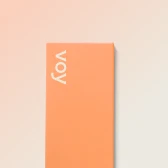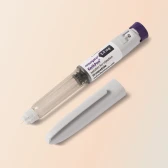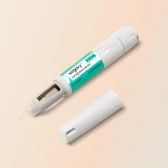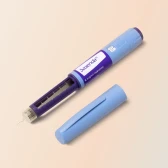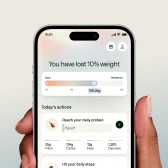Medicines like Mounjaro are in pretty high demand right now. That’s because they work very well to support weight loss - better than diet and exercise changes alone, in fact. As demonstrated in our recent study, engagement with digital services such as Voy can further enhance weight loss outcomes by as much as 26%.
Mounjaro is a medication originally developed to treat type 2 diabetes and is now increasingly used to support weight management. It works by mimicking the effects of natural gut hormones (GLP-1 and GIP) to regulate blood sugar levels and help control appetite. Mounjaro is taken as a once-weekly injection, and learning how to use it correctly is key to ensuring your treatment is both safe and effective.
If you’re considering Mounjaro, you might be wondering exactly how to inject it and where the best Mounjaro injection sites are. While using an injector pen can feel a little daunting at first, the good news is that the process is simple once you know the steps. Below, we guide you through everything you need to know to inject Mounjaro confidently and correctly.
Mounjaro injection video
What is Mounjaro?
First things first: Mounjaro is a medicine used for weight loss, that’s taken alongside healthy changes to diet and exercise.
It works by mimicking the effects of GIP and GLP-1, two “hunger” hormones that are naturally released when you eat. These actions slow down digestion to make you feel fuller, and reduce your appetite and cravings.
Best places to inject Mounjaro
One of the first questions people starting their science-backed weight loss journey often ask is: Where can you inject Mounjaro? Mounjaro is a subcutaneous injection—meaning that it should be injected into the fatty tissue just under your skin, rather than a vein or muscle.
You can inject it into your stomach, thigh, or the back of your upper arm. If you're injecting into the upper arm, you're advised to get someone else to help you administer this safely.
So, where are the best Mounjaro injection sites? We recommend:
Stomach
You can inject Mounjaro into your stomach, at least 5cm away from your belly button.
Thigh
Another option is to inject Mounjaro into the front of your thighs.
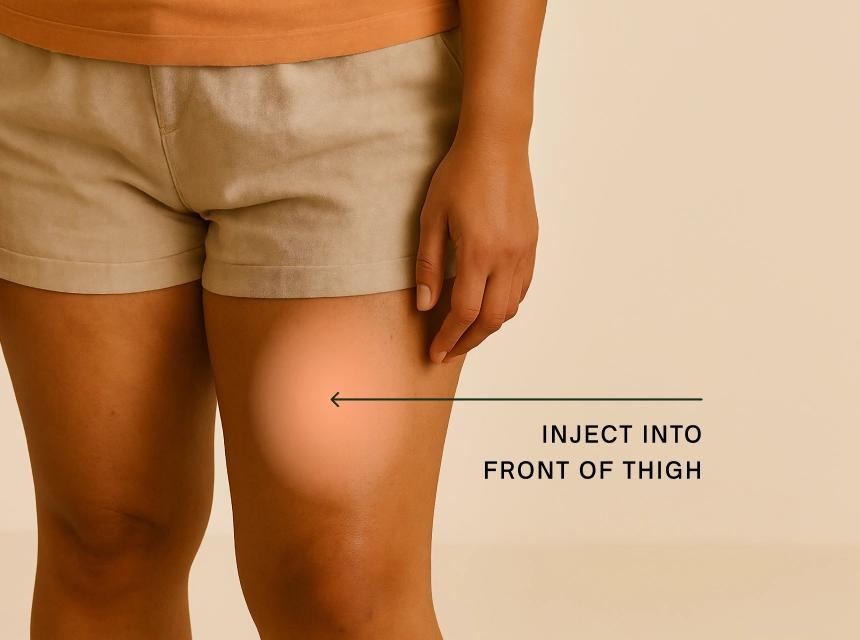
Upper arm
Or you can inject Mounjaro into the back of your upper arm. Here, you’d have to get someone else to do the injection for you.

Mounjaro injection sites to avoid
Avoid injecting Mounjaro into spots where the medicine won’t absorb well or could irritate your skin, such as:
- Scar tissue, hard lumps, or areas with thickened skin
- Bruised, tender, red, or swollen patches
- Stretch‑marked or sunburned skin
- Moles, birthmarks, or tattoos
- Within 2 inches (5 cm) of your navel
- Varicose veins or areas with poor circulation
Stick with the recommended zones—front of the thighs, stomach (away from your belly button), or the back of your upper arm—and rotate sites each time so the tissue stays healthy. If a spot looks or feels off, pick a different one and let it heal before using it again.
Where is the best place to inject Mounjaro?
So, which Mounjaro injection site should you pick? None are “better” than another, or promote more weight loss or fewer side effects, so you can use whichever you prefer. However, some people find injecting into the stomach easier. You might find it helpful to ask a family member or friend to help you when injecting in the upper arm.
Why do I need to use different injection sites?
You can use the same area of your body from week to week, so long as you inject into a different spot each time.
Because if you inject into the same spot again and again, it can cause changes and hardening of the skin texture. This makes it harder for the medicine to be absorbed, which means you might not be getting your full dose. Injecting at a different spot each time will also reduce the chances of irritation at the injection site.
Preparing for a Mounjaro injection
There’s a bit of prep work you need to do before using the pen.
Read the leaflet
We know it sounds obvious, but first, make sure you read the instructions carefully. There should be a leaflet that came with the pens: find it, read it, make sure you understand it.
Wash your hands
Next, give your hands a thorough wash with soap and water.
Check the dose and pen
Take the pen out of the fridge (unused Mounjaro pens should always be kept in the fridge—never the freezer) and check it. You should only use it if:
- The dose is correct
- The medicine hasn’t expired
- The pen hasn’t been damaged
- The medicine isn’t cloudy or discoloured (Mounjaro should be colourless or slightly yellow) and doesn’t have any bits floating in it
- The medicine hasn’t frozen
If you’re good to go on all of the above, you can move on to the next step.
How to inject Mounjaro: A step-by-step guide
Okay, it’s time to do the injection—we know you’ve got this. Carefully follow the steps below.
Prepare your supplies
Make sure you have everything you need to inject Mounarjo, aka:
- Your Mounjaro prefilled pen
- Alcohol swab
- Your needle
- Sharps disposal container
Priming the pen
Before you use a Mounjaro pen every time, you need to prime the pen before injecting it. It’s really important to do this before every injection.
1. Clean the inner seal
Take the cap off the pen and wipe the red inner seal with an alcohol swab.
2. Ready the needle
Next, attach the needle to your pen. Take a needle head and pull off the paper tab at the back. Then, push it onto the pen and twist until it’s tight.
Once the needle head is secure, you can remove both the inner and outer shields protecting the needle. Don’t throw away the outer shield, though—you’ll use it later. The inner shield can go into your regular household rubbish.
Heads up: always use a new needle for each injection. This helps prevent infection and keeps the needles from getting blocked. Read more about Mounjaro needles and why they matter.
3. Select the priming indicator
The small window at the bottom of the pen is called the dose window.
Slowly turn the knob at the end of the pen until you hear two clicks and a long line is shown in the dose window.

Then, hold the pen upright, so the needle is pointing to the ceiling. Tap the cartridge (the bit below the needle you see in the picture) gently. This will allow air bubbles to collect at the top.

4. Final preparations
You then need to check that the pen is in good working order.
Push the dose knob in until it stops and hold it, then slowly count to five. You should see a “0” in the dose window and a tiny drop of liquid coming out of the needle. This means that the pen is primed and ready for use.
If you don’t see any medicine come out, go back to step 3. You can do this twice if you need to. After that, if there still isn’t any liquid coming out, switch pen needles and start the whole process again. And if you still don’t see any liquid after that, contact us and we’ll help you.
Injecting Mounjaro using the pen
Turn the dose knob until a “1” comes up in the window. That means that your dose is loaded up and ready to go. 1 means 1 full dose - so it will always show the 1 symbol, whatever strength you’re taking.
5. Injecting your Mounjaro kwikpen
Insert the needle through the fatty layer. Press the dose knob until it stops. When the dose window shows “0”, you’ve taken your full dose. Count to five slowly. Don’t remove the pen until you see the zero.
Take the pen out. That’s it, all done!
Don’t see the zero? It should show when the injection is finished. First, put the needle back in without turning the dose knob and then press and hold the dose knob until it goes back to 0. If there’s still no zero, get in touch with us - don’t try to start over or give yourself another dose. This could put too much medicine in your system, which might make you feel sick.
After your injection
6. Remove the pen
Carefully remove the pen from the injection site.
7. Monitor the injection site
It’s normal for there to be a drop of blood on your skin right after your injection. If that happens, press lightly onto the injection site with a cotton ball or some gauze. Try not to rub it.
8. Storing Mounjaro safely
Carefully put the outer needle shield back onto the pen. Unscrew the capped needle head and put it into a sharps container. This is important, because if you store the pen with the needle attached it might leak or become blocked.
Pop the pen cap back on until your next injection. You can store used pens in the fridge or at room temperature (up to 30 degrees Celsius).
Note: Never attempt to extract leftover liquid from used pens. Learn why the 'fifth dose' is not recommended.
Not sure how many doses you’ve used? This visual guide shows what your Mounjaro pen looks like after each dose, so you can easily track what’s left and avoid taking too much or too little.

Tips for reducing discomfort when injecting Mounjaro
It’s totally understandable if you’re a bit daunted when you first start injecting Mounjaro, but there are a few things that can help make things feel a bit smoother, such as:
- Make sure to inject at the same time each week.
- Store your Mounjaro properly.
- If your pen’s been in the fridge, allow it to sit at room temperature for 30 minutes before you inject.
- Rotate your injection site each week to prevent irritation.
How do I know if I injected Mounjaro correctly?
What you see on the dose window shows whether you’ve done the injection right.
Before you inject Mounjaro, there should be a “1” in the dose window. This means that the dose is loaded up correctly and that you can use the pen.
When you inject the pen and the window shows “0”, it means that you’ve received the full dose.
Best time to inject Mounjaro
You should take Mounjaro on the same day every week, but it doesn’t matter which time of day you do it.
How often should I inject Mounjaro?
You should inject Mounjaro once a week at the same time each week. We recommend setting an alarm to remind you! If you want to change the day of your dose, make sure you leave at least 72 hours (3 days) between doses.
Mounjaro injection site reaction
You might experience some side effects when using Mounjaro, like nausea or diarrhoea. But for most people, symptoms are mild and go away on their own. You can reduce the chances of side effects by undertaking self-care measures like avoiding trigger foods, eating little but often and drinking plenty of water. Around one in ten people might get some itching, pain, or redness around the injection site.
If your symptoms don’t go away or are becoming a problem, check in with your doctor.
Side effects support at Voy
"If you're using Voy and you experience any side effects, rest assured that our expert clinicians are just a message or phone call away. They can adjust your dose, prescribe medication to ease your symptoms, or simply offer reassurance.
Everyone responds differently to weight loss treatment and we'll help you find what feels right for you."

Reducing pain after injecting Mounjaro
Some people find that their injection site hurts after using Mounjaro. Here, as suggested above, you could try applying gentle pressure to that spot. It sounds simple, but scientific research shows that this can help to reduce pain.
Applying an ice pack to the sore area is also an option and you can also use over-the-counter painkillers like paracetamol. Should the pain stick around or get worse, ask your doctor for advice.
Your next steps
We get that starting out with Mounjaro feels like a big step—in many ways, it is. Deciding to try a new medicine isn’t something done lightly.
But really, your weight loss journey is a series of little steps, done again and again and again. It’s about building habits that last: you’ll get the most out of Mounjaro when you use it for at least a year.
And we’re here to cheer you on at each stage of that journey. In our weight loss programme, you can get support from our team of experts plus weekly medication, and access to our coaching app to track your progress. Fill out this short form to find out if it’s right for you, it won’t take more than a few minutes.
